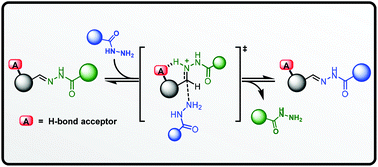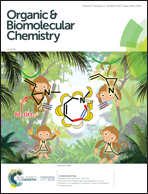Enhancing the kinetics of hydrazone exchange processes: an experimental and computational study†
Abstract
The capacity of hydrazone bonds to readily undergo component exchange processes sees their extensive utilization in dynamic combinatorial chemistry. The kinetics of hydrazone exchange are optimal at pH ∼4.5, which limits the use of hydrazone-based dynamic combinatorial libraries, particularly for biological targets which are only stable at near-neutral pH values. It would thus be advantageous if hydrazone exchange proceeded with faster rates at pH values closer to neutral. We experimentally and computationally evaluated the hypothesis that hydrazones possessing neighbouring acidic or basic functional groups within the carbonyl-derived moitety of the hydrazone would enhance exchange rates. Our work suggests that judiciously placed N- or O-hydrogen bond acceptors within the carbonyl-derived moiety of the hydrazone stabilize transition states via hydrogen bonding interactions, providing a valuable boost to exchange kinetics at near-neutral pH values. We anticipate these findings will be of interest in dynamic combinatorial chemistry, dynamic covalent polymers/materials, functionalized nanoparticles and interlocked molecules, all of which may benefit from hydrazone exchange processes able to operate at near-neutral pH values.

- This article is part of the themed collection: Mechanistic, computational & physical organic chemistry in OBC


 Please wait while we load your content...
Please wait while we load your content...